A Joint Scheduling Scheme for WiFi Access TSN
Abstract
1. Introduction
2. Related Work
2.1. TSN Scheduling-Related Research
2.2. Research Related to Wireless Time Sensitive Networks (WTSN)
3. Problem Statement
- The oversimplified traffic control methods in conventional Ethernet can lead to cache congestion or even blocking in the WiFi device at the receiving end, seriously affecting the transmission of time-sensitive service data streams.
- Shared wireless links between access points (AP). Unlike Ethernet, wireless terminals experience channel contention when they are uploading data, which increases the latency and decreases the reliability of time-sensitive streams. Therefore, wireless terminals need to upload time-sensitive streams to wireless APs according to the specified time slots.
- Queue resource division problem. In order to improve the transmission quality of delay-sensitive data, Enhanced Distributed Coordinated Access (EDCA) has been introduced in WiFi, which divides all the traffic into four different access classes, each with a different Transmission Opportunity (TXOP), arbitrated inter-frame space number (AIFSN), and minimum and maximum contention window (CWmin and CWmax), respectively. EDCA is able to increase transmission opportunities for high-priority traffic by reducing the backoff time and arbitration inter-frame space. The switches in a time-sensitive network are divided into eight priority queues, each of which is controlled by a gate control queue (GCL) that controls the queue’s transmission and wait states. This means that WiFi transmissions cannot control their QoS by queuing up data with different priorities into different queues. The sending mechanism for both is shown in Figure 1 and Figure 2.
- Wireless link transmission uncertainty problem. Wireless links always face the problem of data transmission failure; the solution in WiFi is to introduce the ACK mechanism for retransmission to ensure the certainty of data transmission, but this method increases the delay substantially.
4. Description of the System Model
- (1)
- Time-sensitive traffic does not stay in the switch or AP, avoiding traffic congestion in the AP due to different wired-wireless transmission rates.
- (2)
- The no-wait transmission model allows time-sensitive traffic to occupy only one queue for transmission, which avoids mutual interference between traffic flows. Since wireless transmission inevitably encounters packet loss, retransmission of time-sensitive flows can result in increased jitter and wasted bandwidth. The scenarios addressed in this paper assume that the packet loss rate of wireless transmission is within the tolerance of the control system, considering that most control applications allow for a small number of packet losses or deadline misses without significantly affecting their performance. However, in the queuing model, packet loss can cause timing disruption, as shown in Figure 1, in queue 7: if according to the transmission time scheduled by TAS scheduling, frame 1 should start transmission and frame 2 is in the waiting queue and if packet loss occurs because of the wireless transmission of frame 1, then it will lead to the early start of the transmission of frame 2, which leads to the failure of the time window scheduling and increases the jitter and delay of the transmission.
- Time slot reservation constraints
- 2.
- Injection time constraints
- 3.
- Transmission instance sending time constraints
- 4.
- Flow transmission constraint
- 5.
- Link conflict-free constraints
- 6.
- Delay constraints
- 7.
- Flow Span Constraints
5. Algorithm Design
- Initialize a population of candidate solutions .
- Repeat Step 3–Step 5 and loop until the termination criterion is reached.
- According to the size of fitness, select individuals from , where
- Based on the statistics of the individuals selected above.
- Generate a new population from the statistics.
| Algorithm 1: Inject Time Based on Flow Sequence. |
| Input: Flow information , Network topology model , Sequence of flow generated by EDA Output: Flow span |
| 1: ← 0 2: for each flow in : 3: 4: ← 5: endfor 6: return |
- Stream order-based codecs
- 2.
- Initialize the probability matrix
- 3.
- Generate children through the probability matrix
- 4.
- Calculate the fitness of children
- 5.
- Probability matrix update method
- 6.
- Loop
| Algorithm 2: Flow Sequence Generator Based on EDA. |
| Input: Flow information , Network topology model Output: minimum flowspan best |
| 1: Initial probability matrix() 2: best = max fitness(population) 3: while Iterations < maxIterations do: 4: selection result = selection(population) 5: = update probability model(selection result) 6: If max fitness(selection result) > best: 7: best = max fitness(selection result) 8: population = sampling() 9: Iterations = Iterations + 1 10: EndWhile 11: return best |
6. Evaluation of Experimental Results
6.1. Description of Experimental Conditions
6.2. Performance Evaluation of the Algorithm in This Paper
6.3. Comparison with Other Algorithms
7. Conclusions
Author Contributions
Funding
Institutional Review Board Statement
Informed Consent Statement
Data Availability Statement
Conflicts of Interest
References
- Ashjaei, M.; Lo Bello, L.; Daneshtalab, M.; Patti, G.; Saponara, S.; Mubeen, S. Time-Sensitive Networking in automotive embedded systems: State of the art and research opportunities. J. Syst. Archit. 2021, 117, 102137. [Google Scholar] [CrossRef]
- Steiner, W.; Bauer, G.; Hall, B.; Paulitsch, M. Time-triggered ethernet. In Time-Triggered Communication; CRC Press: Boca Raton, FL, USA, 2018; pp. 209–248. [Google Scholar]
- Feld, J. PROFINET—Scalable Factory Communication for All Applications. In Proceedings of the IEEE International Workshop on Factory Communication Systems, Vienna, Austria, 22–24 September 2004; Proceedings. IEEE: Piscataway, NJ, USA, 2004; pp. 33–38. [Google Scholar]
- Prytz, G. A Performance Analysis of EtherCAT and PROFINET IRT. In Proceedings of the 2008 IEEE International Conference on Emerging Technologies and Factory Automation, Hamburg, Germany, 15–18 September 2008; IEEE: Piscataway, NJ, USA, 2008; pp. 408–415. [Google Scholar]
- IEEE Std 802.1AS-2020 (Revision of IEEE Std 802.1AS-2011); IEEE Standard for Local and Metropolitan Area Networks—Timing and Synchronization for Time-Sensitive Applications. IEEE: Piscataway, NJ, USA, 2020; pp. 1–421.
- IEEE Std 802.1Qav-2009 (Amendment to IEEE Std 802.1Q-2005); IEEE Standard for Local and Metropolitan Area Networks—Virtual Bridged Local Area Networks Amendment 12: Forwarding and Queuing Enhancements for Time-Sensitive Streams. IEEE: Piscataway, NJ, USA, 2010; pp. C1–C72.
- IEEE Std 802.1Qcr-2020 (Amendment to IEEE Std 802.1Q-2018 as Amended by IEEE Std 802.1Qcp-2018, IEEE Std 802.1Qcc-2018, IEEE Std 802.1Qcy-2019, and IEEE Std 802.1Qcx-2020); IEEE Standard for Local and Metropolitan Area Networks–Bridges and Bridged Networks-Amendment 34: Asynchronous Traffic Shaping. IEEE: Piscataway, NJ, USA, 2020; pp. 1–151. [CrossRef]
- IEEE Std 802.1Qbv-2015 (Amendment to IEEE Std 802.1Q-2014 as Amended by IEEE Std 802.1Qca-2015, IEEE Std 802.1Qcd-2015, and IEEE Std 802.1Q-2014/Cor 1-2015); IEEE Standard for Local and metropolitan area networks—Bridges and Bridged Networks-Amendment 25: Enhancements for Scheduled Traffic. IEEE: Piscataway, NJ, USA, 2016; pp. 1–57. [CrossRef]
- IEEE Std 802.1Qbu-2016 (Amendment to IEEE Std 802.1Q-2014); IEEE Standard for Local and Metropolitan Area Networks—Bridges and Bridged Networks—Amendment 26: Frame Preemption. IEEE: Piscataway, NJ, USA, 2016; pp. 1–52. [CrossRef]
- IEEE Std 802.1Qci-2017 (Amendment to IEEE Std 802.1Q-2014 as Amended by IEEE Std 802.1Qca-2015, IEEE Std 802.1Qcd-2015, IEEE Std 802.1Q-2014/Cor 1-2015, IEEE Std 802.1Qbv-2015, IEEE Std 802.1Qbu-2016, and IEEE Std 802.1Qbz-2016); IEEE Standard for Local and Metropolitan Area networks–Bridges and Bridged Networks–Amendment 28: Per-Stream Filtering and Policing. IEEE: Piscataway, NJ, USA, 2017; pp. 1–65. [CrossRef]
- IEEE Std 802.1CB-2017; IEEE Standard for Local and metropolitan area networks–Frame Replication and Elimination for Reliability. IEEE: Piscataway, NJ, USA, 2017; pp. 1–102. [CrossRef]
- IEEE Std 802.1Qcc-2018 (Amendment to IEEE Std 802.1Q-2018 as Amended by IEEE Std 802.1Qcp-2018); IEEE Standard for Local and Metropolitan Area Networks–Bridges and Bridged Networks—Amendment 31: Stream Reservation Protocol (SRP) Enhancements and Performance Improvements. IEEE: Piscataway, NJ, USA, 2018; pp. 1–208. [CrossRef]
- Cavalcanti, D.; Cordeiro, C.; Smith, M.; Regev, A. WiFi TSN: Enabling Deterministic Wireless Connectivity over 802.11. IEEE Commun. Stand. Mag. 2022, 6, 22–29. [Google Scholar] [CrossRef]
- Hiertz, G.R.; Denteneer, D.; Stibor, L.; Zang, Y.; Costa, X.P.; Walke, B. The IEEE 802.11 universe. IEEE Commun. Mag. 2010, 48, 62–70. [Google Scholar] [CrossRef]
- Stüber, T.; Osswald, L.; Lindner, S.; Menth, M. A survey of scheduling algorithms for the time-aware shaper in time-sensitive networking (TSN). IEEE Access 2023, 11, 61192–61233. [Google Scholar] [CrossRef]
- Craciunas, S.S.; Oliver, R.S.; Chmelík, M.; Steiner, W. Scheduling Real-Time Communication in IEEE 802.1Qbv Time Sensitive Networks. In Proceedings of the 24th International Conference on Real-Time Networks and Systems, Brest, France, 19–21 October 2016; pp. 183–192. [Google Scholar]
- Falk, J.; Dürr, F.; Rothermel, K. Exploring practical limitations of joint routing and scheduling for TSN with ILP. In Proceedings of the 2018 IEEE 24th International Conference on Embedded and Real-Time Computing Systems and Applications (RTCSA), Hokkaido, Japan, 28–31 August 2018; IEEE: Piscataway, NJ, USA, 2018; pp. 136–146. [Google Scholar]
- Laursen, S.M.; Pop, P.; Steiner, W. Routing optimization of AVB streams in TSN networks. ACM Sigbed Rev. 2016, 13, 43–48. [Google Scholar] [CrossRef]
- Pahlevan, M.; Obermaisser, R. Genetic algorithm for scheduling time-triggered traffic in time-sensitive networks. In Proceedings of the 2018 IEEE 23rd international conference on emerging technologies and factory automation (ETFA), Torino, Italy, 4–7 September 2018; IEEE: Piscataway, NJ, USA, 2018; pp. 337–344. [Google Scholar]
- Zhang, Y.; Wu, J.; Liu, M.; Tan, A. TSN-based routing and scheduling scheme for Industrial Internet of Things in underground mining. Eng. Appl. Artif. Intell. 2022, 115, 105314. [Google Scholar] [CrossRef]
- Dürr, F.; Nayak, N.G. No-wait Packet Scheduling for IEEE Time-sensitive Networks (TSN). In Proceedings of the 24th International Conference on Real-Time Networks and Systems, Brest, France, 19–21 October 2016; pp. 203–212. [Google Scholar]
- Vlk, M.; Brejchová, K.; Hanzálek, Z.; Tang, S. Large-scale periodic scheduling in time-sensitive networks. Comput. Oper. Res. 2022, 137, 105512. [Google Scholar] [CrossRef]
- Atallah, A.A.; Hamad, G.B.; Mohamed, O.A. Routing and Scheduling of Time-Triggered Traffic in Time-Sensitive Networks. IEEE Trans. Ind. Inform. 2020, 16, 4525–4534. [Google Scholar] [CrossRef]
- Adame, T.; Carrascosa, M.; Bellalta, B. Time-sensitive networking in IEEE 802.11 be: On the way to low-latency WiFi 7. arXiv 2019, arXiv:1912.06086. [Google Scholar]
- Bush, S.F.; Mantelet, G.; Thomsen, B.; Grossman, E. Industrial wireless time-sensitive networking: RFC on the path forward. In Avnu Alliance White Paper; Avnu Alliance: Beaverton, OR, USA, 2018. [Google Scholar]
- Seijo, O.; Fernández, Z.; Val, I.; López-Fernández, J.A. SHARP: Towards the integration of time-sensitive communications in legacy LAN/WLAN. In Proceedings of the 2018 IEEE Globecom Workshops (GC Wkshps), Abu Dhabi, United Arab Emirates, 9–13 December 2018; IEEE: Piscataway, NJ, USA, 2018; pp. 1–7. [Google Scholar]
- Genc, E.; Del Carpio, L.F. Wi-Fi QoS enhancements for downlink operations in industrial automation using TSN. In Proceedings of the 2019 15th IEEE International Workshop on Factory Communication Systems (WFCS), Sundsvall, Sweden, 27–29 May 2019; IEEE: Piscataway, NJ, USA, 2019; pp. 1–6. [Google Scholar]
- Akhmetov, D.; Das, D.; Cavalcanti, D.; Ramirez-Perez, J.; Cariou, L. Scheduled Time-Sensitive Transmission Opportunities over Wi-Fi. In Proceedings of the GLOBECOM 2022–2022 IEEE Global Communications Conference, Rio de Janeiro, Brazil, 4–8 December 2022; pp. 1807–1812. [Google Scholar]
- Haxhibeqiri, J.; Jiao, X.; Campos, P.A.; Moerman, I.; Hoebeke, J. To update or not: Dynamic traffic classification for high priority traffic in wireless TSN. In Proceedings of the 2023 IEEE 19th International Conference on Factory Communication Systems (WFCS), Pavia, Italy, 26–28 April 2023; IEEE: Piscataway, NJ, USA, 2023; pp. 1–8. [Google Scholar]
- Tindell, K.W.; Burns, A.; Wellings, A.J. Allocating hard real-time tasks: An NP-hard problem made easy. Real-Time Syst. 1992, 4, 145–165. [Google Scholar] [CrossRef]
- Steiner, W. An evaluation of SMT-based schedule synthesis for time-triggered multi-hop networks. In Proceedings of the 2010 31st IEEE Real-Time Systems Symposium, Austin, TX, USA, 10–13 April 2022; pp. 375–384. [Google Scholar]
- Cavalcanti, D.V.G.; Fang, J.; Das, D.; Cariou, L.; Smith, M.; Seewald, M. Wi-Fi and TSN Enabling Deterministic Wireless for Time-Sensitive Applications. Available online: https://mentor.ieee.org/802.11/dcn/22/11-22-0080-00-0000-wi-fi-and-tsn-enabling-deterministic-wireless-for-time-sensitive-applications.pptx (accessed on 19 January 2022).
- Cavalcanti, D.V.G.; Fang, J.; Das, D.; Cariou, L.; Smith, M.; Seewald, M. Wireless TSN in 802.11 and New Requirements for 802.11be and 802.1. Available online: https://mentor.ieee.org/802.11/dcn/21/11-21-0628-00-00be-wireless-tsn-in-802-11-and-new-requirements-for-802-11be-and-802-1.pptx (accessed on 19 April 2021).
- Wang, X.; Yao, H.; Mai, T.; Nie, T.; Zhu, L.; Liu, Y. Deep Reinforcement Learning aided No-wait Flow Scheduling in Time-Sensitive Networks. In Proceedings of the 2022 IEEE Wireless Communications and Networking Conference (WCNC), Austin, TX, USA, 10–13 April 2022; pp. 812–817. [Google Scholar]
- Larrañaga, P.; Lozano, J.A. Estimation of Distribution Algorithms: A New Tool for Evolutionary Computation; Springer Science & Business Media: Berlin/Heidelberg, Germany, 2001; Volume 2. [Google Scholar]
- Wang, L.; Fang, C. A hybrid estimation of distribution algorithm for solving the resource-constrained project scheduling problem. Expert Syst. Appl. 2012, 39, 2451–2460. [Google Scholar] [CrossRef]
- Macchiaroli, R.; Mole, S.; Riemma, S. Modelling and optimization of industrial manufacturing processes subject to no-wait constraints. Int. J. Prod. Res. 1999, 37, 2585–2607. [Google Scholar] [CrossRef]
- Platt, E.L. Network Science with Python and NetworkX Quick Start Guide: Explore and Visualize Network Data Effectively; Packt Publishing Ltd.: Birmingham, UK, 2019. [Google Scholar]
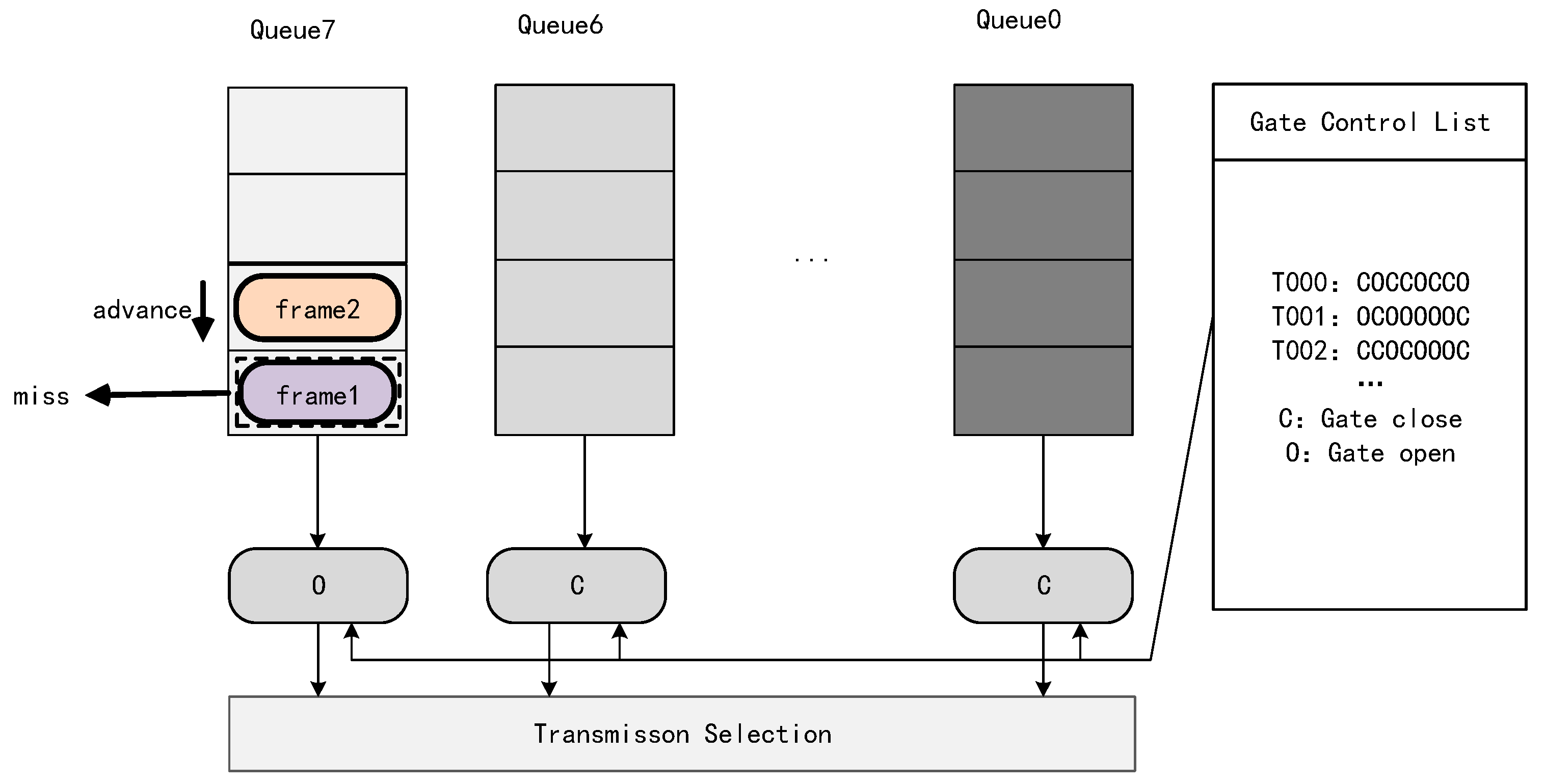
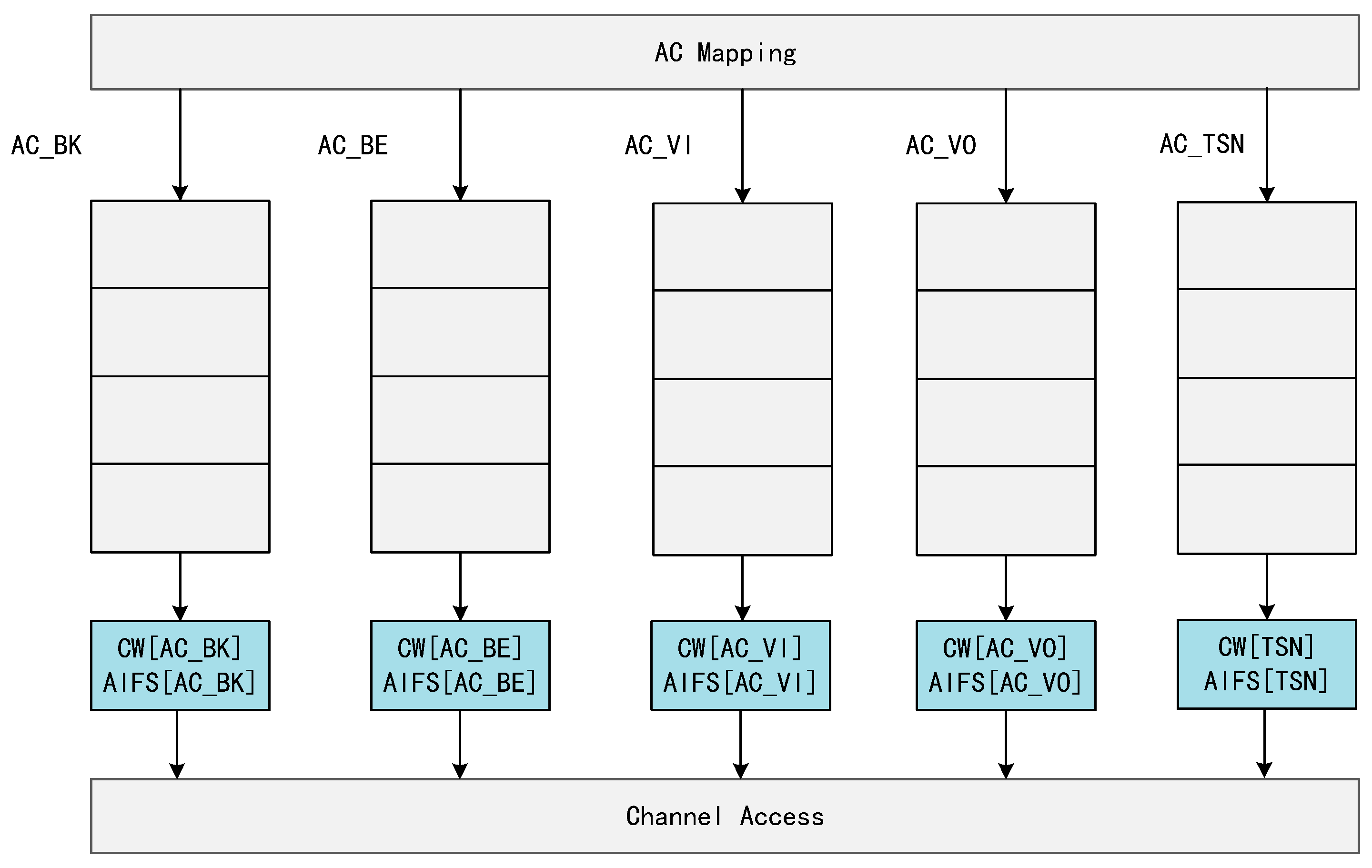
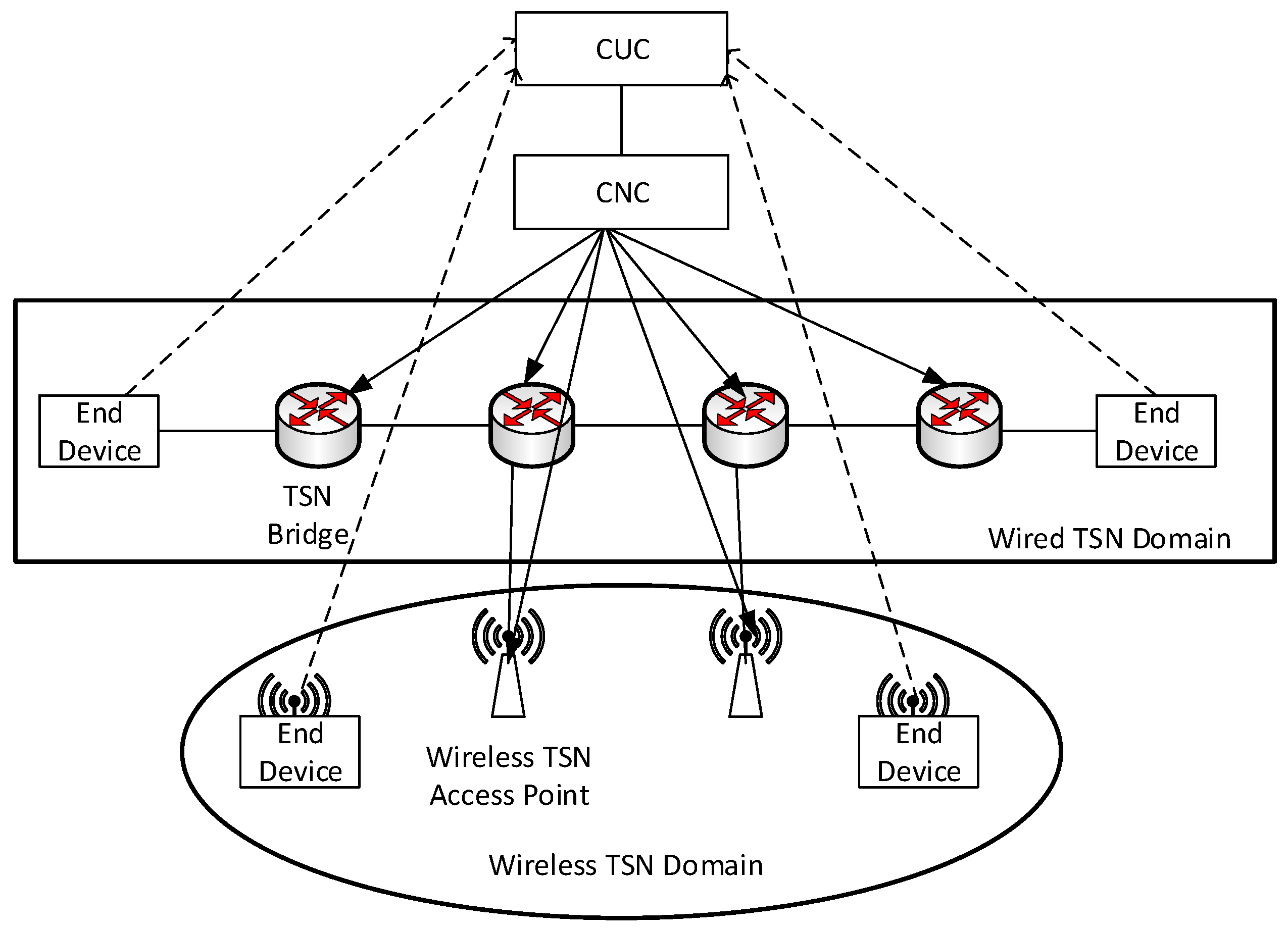
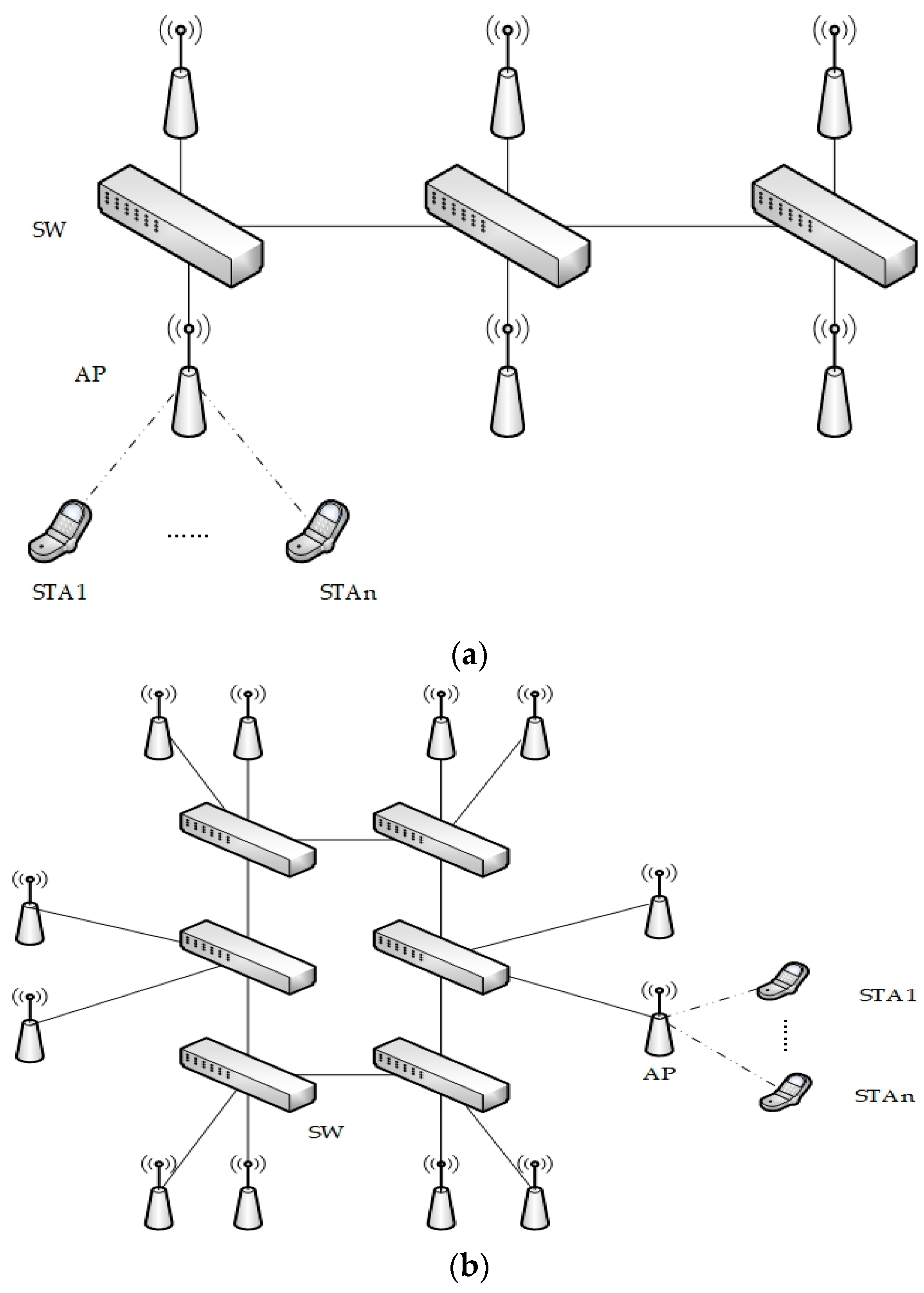

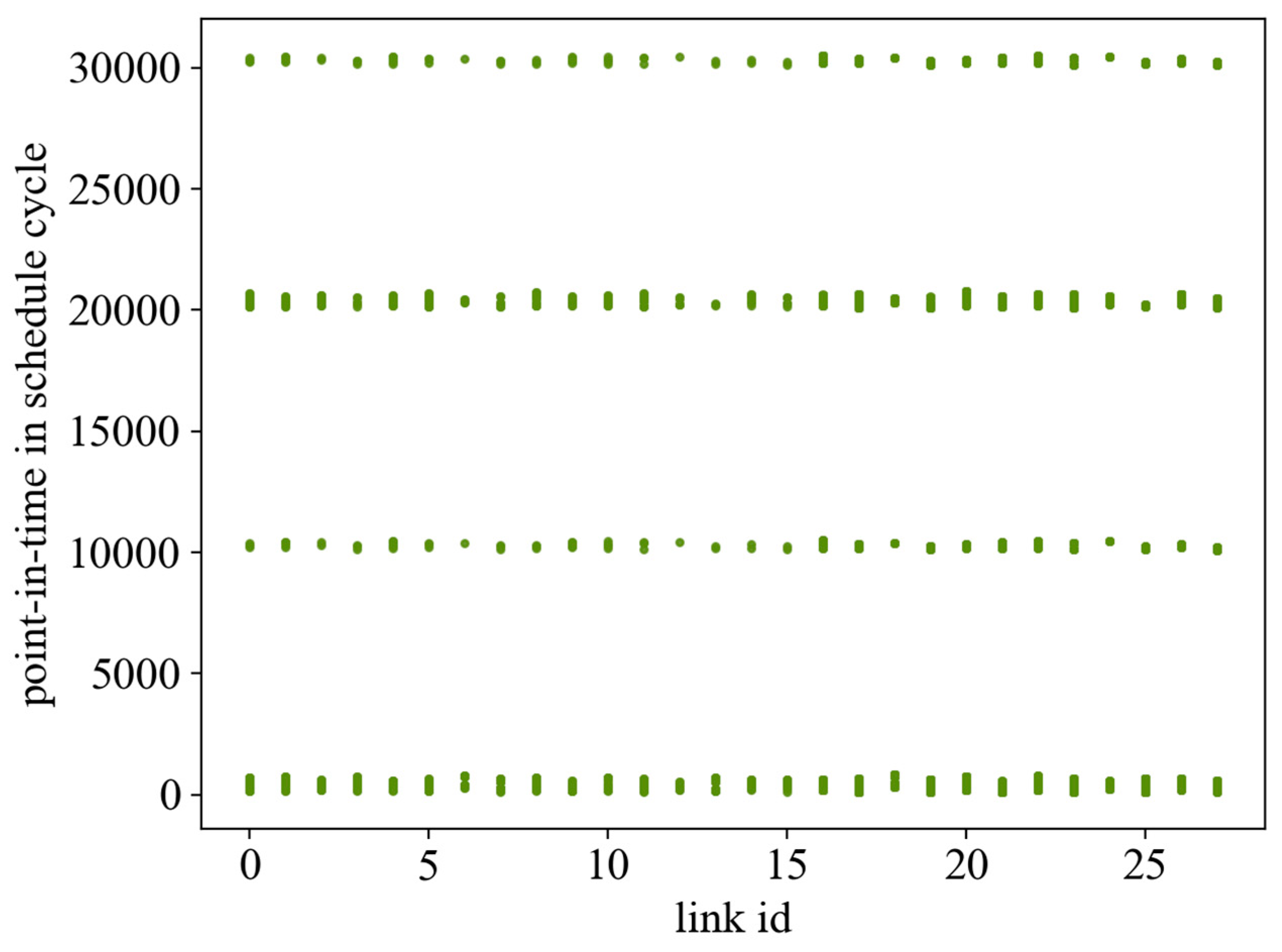

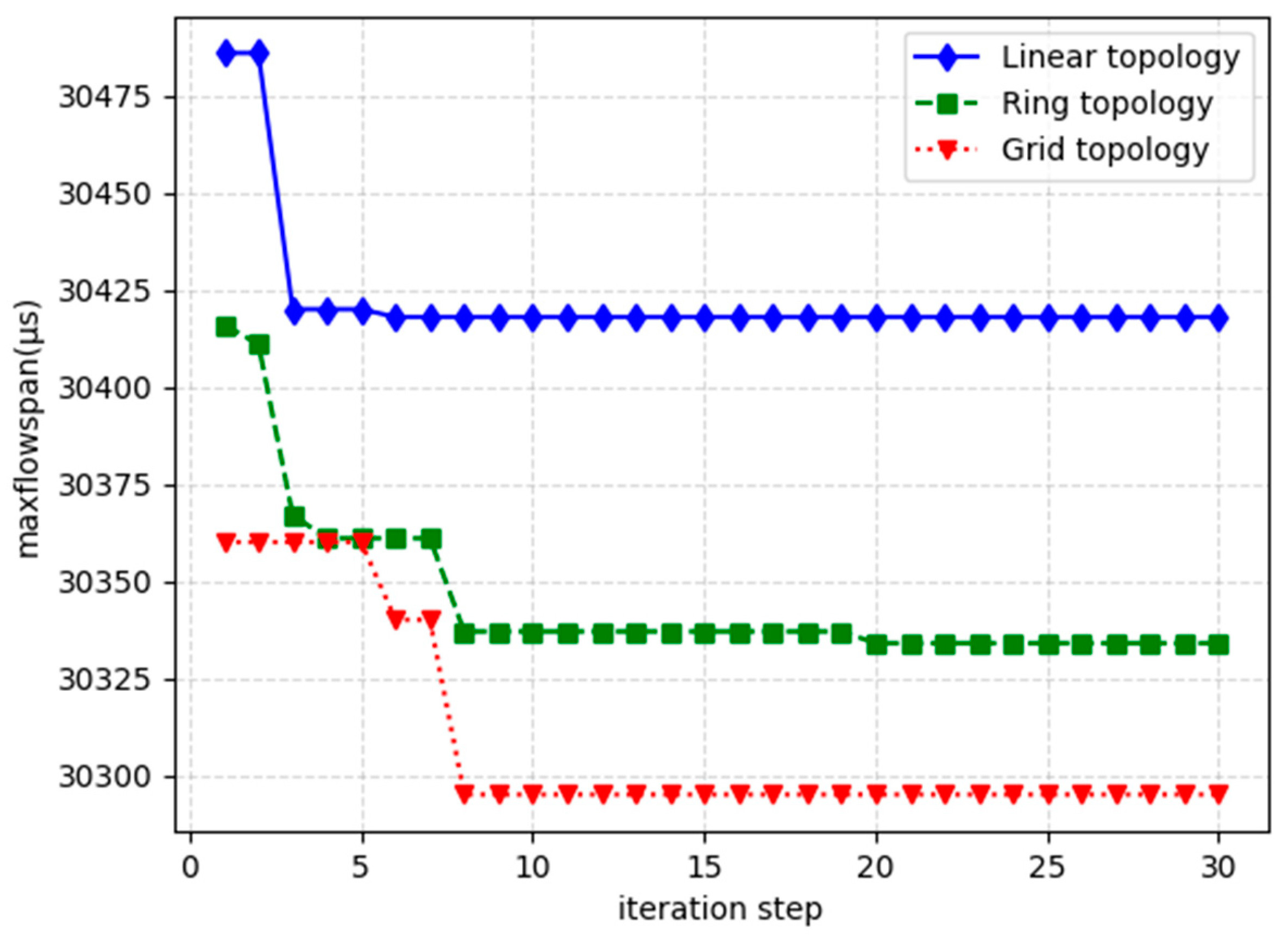
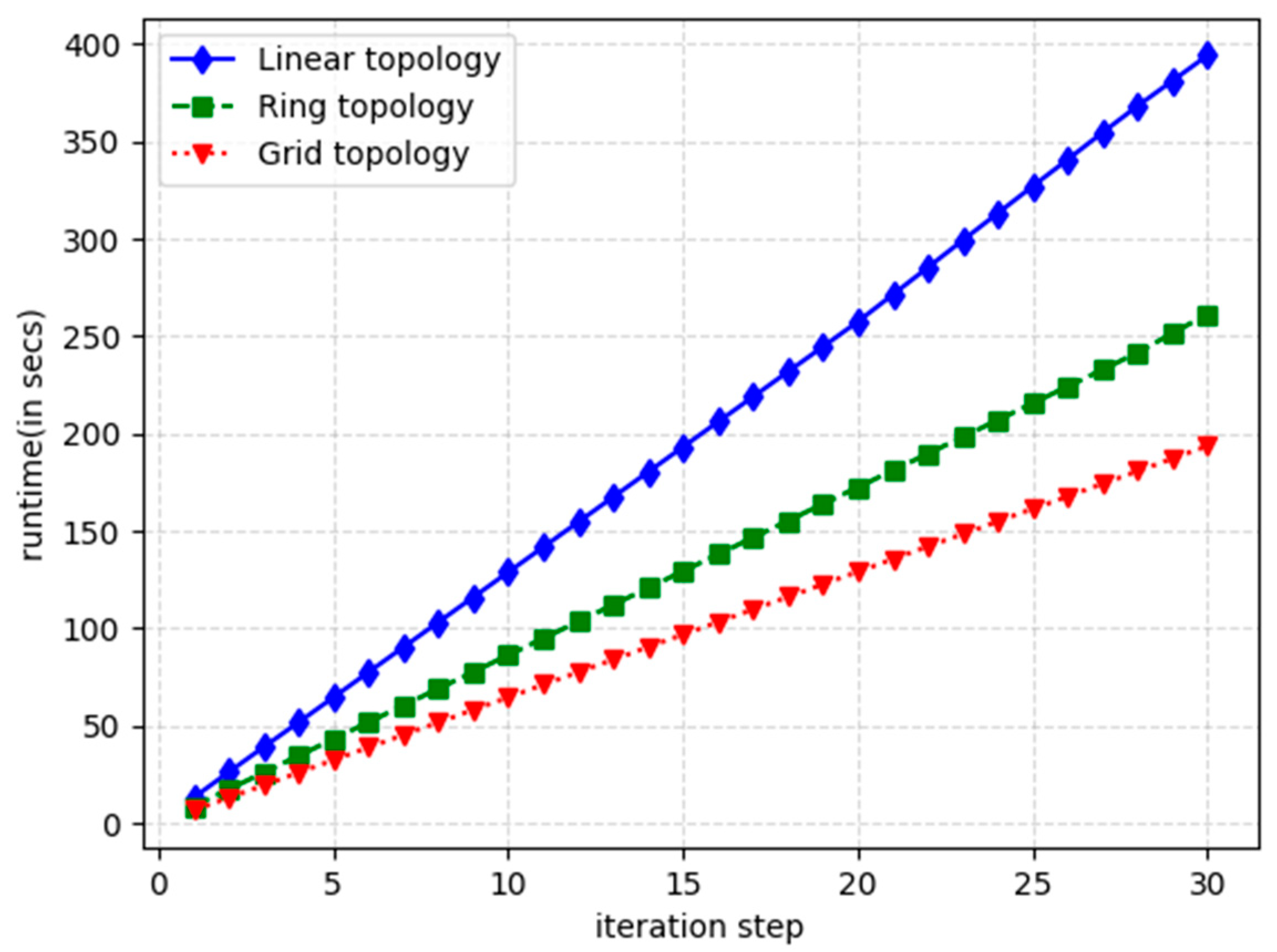



| Parameter | Value or Range |
|---|---|
| Topology | Linear, Ring, Grid |
| Request time period | [10 ms, 20 ms, 40 ms] |
| Latency requirement | [0.5 ms, 1 ms, 2 ms] |
| Frame size | [125 B, 250 B, 500 B] |
| Wireless Tx speed | 100 Mbps |
| Wired Tx speed | 1000 Mbps |
| Node processing time | |
| Link propagation delay | |
| Reserve transmission time for beacon frames |
Disclaimer/Publisher’s Note: The statements, opinions and data contained in all publications are solely those of the individual author(s) and contributor(s) and not of MDPI and/or the editor(s). MDPI and/or the editor(s) disclaim responsibility for any injury to people or property resulting from any ideas, methods, instructions or products referred to in the content. |
© 2024 by the authors. Licensee MDPI, Basel, Switzerland. This article is an open access article distributed under the terms and conditions of the Creative Commons Attribution (CC BY) license (https://creativecommons.org/licenses/by/4.0/).
Share and Cite
Li, Z.; Yang, J.; Guo, C.; Xiao, J.; Tao, T.; Li, C. A Joint Scheduling Scheme for WiFi Access TSN. Sensors 2024, 24, 2554. https://doi.org/10.3390/s24082554
Li Z, Yang J, Guo C, Xiao J, Tao T, Li C. A Joint Scheduling Scheme for WiFi Access TSN. Sensors. 2024; 24(8):2554. https://doi.org/10.3390/s24082554
Chicago/Turabian StyleLi, Zhong, Jianfeng Yang, Chengcheng Guo, Jinsheng Xiao, Tao Tao, and Chengwang Li. 2024. "A Joint Scheduling Scheme for WiFi Access TSN" Sensors 24, no. 8: 2554. https://doi.org/10.3390/s24082554
APA StyleLi, Z., Yang, J., Guo, C., Xiao, J., Tao, T., & Li, C. (2024). A Joint Scheduling Scheme for WiFi Access TSN. Sensors, 24(8), 2554. https://doi.org/10.3390/s24082554







